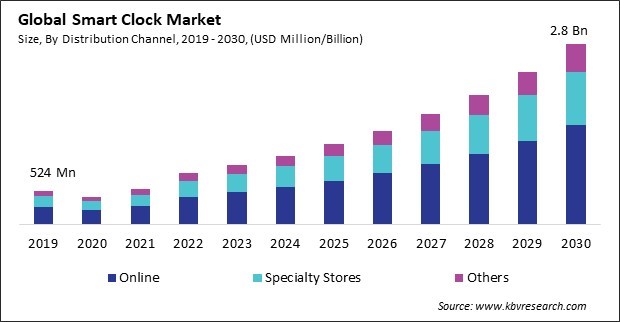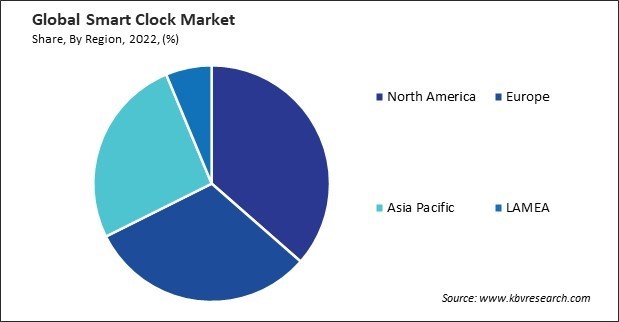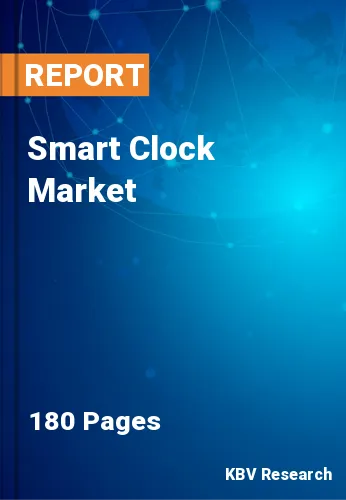“Global Smart Clock Market to reach a market value of USD 2.8 Billion by 2030 growing at a CAGR of 17.2%”
The Global Smart Clock Market size is expected to reach $2.8 billion by 2030, rising at a market growth of 17.2% CAGR during the forecast period. In the year 2022, the market attained a volume of 17,103.4 thousand units, experiencing a growth of 16.9% (2019-2022).
Vobot Smart Alarm Clock, Amazon, Lenovo, SDI Technologies, and Kickstarter are among the major manufacturers working on producing new products to attract the greatest number of customers possible. Consequently, the North America region captured $292.7 million revenue in the market in 2022. The reason for this is the growing demand for products related to home automation. For example, in January 2018, SDI Technologies, Inc. introduced a cutting-edge smart clock developed with Google Assistant and marketed under the iHome iGV1 brand. The region's expansion is anticipated to be further bolstered by this aspect.

Smart clocks, when integrated into smart home ecosystems, become central hubs for controlling various smart devices. Users can manage and monitor connected devices such as lights, thermostats, security cameras, and more directly from their smart clock. This centralized control simplifies the user experience and enhances convenience. Integration with virtual assistants like Amazon Alexa, Google Assistant, or Apple's Siri empowers these with voice command capabilities. Also, users can control their clocks and other smart devices in their homes using voice commands, contributing to a hands-free and efficient living environment. Additionally, increasing disposable income allows a broader population to afford these. As disposable income grows, consumers are more willing to allocate funds to purchase technology products. This, a fusion of traditional timekeeping and advanced functionalities, appeal to consumers seeking innovative and feature-rich gadgets. Consumers with higher disposable income are often attracted to premium models of these that offer advanced features, high-quality materials, and elegant designs. As a result, the increasing disposable income of individuals creates a favorable environment for the market.
However, many clocks require regular charging, often daily or every few days. This frequent charging demand contrasts with traditional watches that can operate for an extended period without being charged. Users may find this need for regular charging inconvenient and disruptive to their daily routines. These are dependent on power sources, and the need to connect them to charging cables or docking stations can limit their use during charging periods. This dependency may be perceived as a drawback, particularly when access to a power source is limited. Using proprietary charging cables and connectors for these can lead to compatibility issues. Users may face challenges finding suitable charging accessories or replacements, limiting their ability to charge the device if the original cable is lost or damaged. Due to the above factors, market growth will be hampered in the coming years.
On the basis of distribution channel, the market is segmented into speciality stores, online, and others. In 2022, the online segment dominated the market with the maximum revenue share. Amazon is a global e-commerce giant that offers an extensive range of smart clocks from various brands. Customers can find various options, including smartwatches, digital clocks, and clock radios with smart features. Many manufacturers sell their products directly through their official websites. If the consumer has a specific brand or model in mind, visiting the official website can provide them with detailed information and the option to purchase.

Free Valuable Insights: Global Smart Clock Market size to reach USD 2.8 Billion by 2030
Region-wise, the market is analyzed across North America, Europe, Asia Pacific, and LAMEA. The Asia Pacific region garnered a significant revenue share in the market in 2022. The most important factor that is anticipated to contribute to the region's expansion is the rise in the purchasing power of consumers in rising economies: China and India. Furthermore, various opportunities will be made available to market participants due to the growing awareness of the Internet of Things in countries such as Singapore, Japan, and South Korea. Ongoing innovation in technology and efforts to differentiate products in design, features, and price points have fueled consumer interest and market growth.
| Report Attribute | Details |
|---|---|
| Market size value in 2022 | USD 803.3 Million |
| Market size forecast in 2030 | USD 2.8 Billion |
| Base Year | 2022 |
| Historical Period | 2019 to 2021 |
| Forecast Period | 2023 to 2030 |
| Revenue Growth Rate | CAGR of 17.2% from 2023 to 2030 |
| Number of Pages | 180 |
| Number of Table | 329 |
| Quantitative Data | Volume in Thousand Units, Revenue in USD Billion, and CAGR from 2019 to 2030 |
| Report coverage | Market Trends, Revenue Estimation and Forecast, Segmentation Analysis, Regional and Country Breakdown, Porter’s 5 Forces Analysis, Company Profiling, Companies Strategic Developments, SWOT Analysis, Winning Imperatives |
| Segments covered | Distribution Channel, Region |
| Country scope |
|
| Companies Included | Amazon.com, Inc., SDI Technologies, Inc., Lenovo Group Limited, Emerson Electric Co., Sony Corporation, Koninklijke Philips N.V., Panasonic Holdings Corporation, Samsung Electronics Co., Ltd. (Samsung Group), Google LLC (Alphabet Inc.) and Bose Corporation |
By Distribution Channel (Volume, Thousand Units, USD Billion, 2019-2030)
By Geography (Volume, Thousand Units, USD Billion, 2019-2030)
The Market size is projected to reach USD $2.8 billion by 2030.
Integration with smart home ecosystems are driving the Market in coming years, however, Issue of battery life and charging restraints the growth of the Market.
Amazon.com, Inc., SDI Technologies, Inc., Lenovo Group Limited, Emerson Electric Co., Sony Corporation, Koninklijke Philips N.V., Panasonic Holdings Corporation, Samsung Electronics Co., Ltd. (Samsung Group), Google LLC (Alphabet Inc.) and Bose Corporation
In the year 2022, the market attained a volume of 17,103.4 thousand units, experiencing a growth of 16.9% (2019-2022).
The North America region dominated the Market by Region in 2022, and would continue to be a dominant market till 2030; thereby, achieving a market value of $988.7 million by 2030.
Our team of dedicated experts can provide you with attractive expansion opportunities for your business.

 Drivers
Drivers
 Restraints
Restraints
 Opportunities
Opportunities
 Challenges
Challenges
